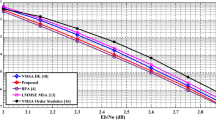Abstract
In this paper, a method to approximate the second minimum required in the computation of the check node update of an LDPC decoder based on min-sum algorithm is presented. The proposed approximation compensates the performance degradation caused by the utilization of a first minimum and pseudo-second minimum finder instead of a true two minimum finder in the min-sum algorithm and improves the BER performance of high-rate LDPC codes in the error floor region. This approach applied to a complete decoder reduces the critical path and the area with independence of the selected architecture. Therefore, this method increases the maximum throughput achieved by the decoder and its area-throughput efficiency. The increase in efficiency is proportional to the degree of the check node, so the higher the code rate is, the higher the improvement in area and speed is.





Similar content being viewed by others
Notes
It is assumed, without loss of generality, that the \(d_\mathrm{c}\) messages are identically distributed.
References
L. Amaru, M. Martina, G. Masera, High speed architectures for finding the first two maximum/minimum values. IEEE Trans. Very Large Scale Integr. (VLSI) Syst. 20(12), 2342–2346 (2012). https://doi.org/10.1109/TVLSI.2011.2174166
F. Angarita, V. Torres, A. Perez-Pascual, J. Valls, High-throughput FPGA-based emulator for structured LDPC codes. in 19th IEEE International Conference on Electronics, Circuits and Systems (ICECS) (2012), pp. 404–407. https://doi.org/10.1109/ICECS.2012.6463664
F. Angarita, J. Valls, V. Almenar, V. Torres, Reduced-complexity min-sum algorithm for decoding LDPC codes with low error-floor. IEEE Tran. Circuits Syst. I Regul. Pap. 61(7), 2150–2158 (2014). https://doi.org/10.1109/TCSI.2014.2304660
D. Bao, X. Chen, Y. Huang, C. Wu, Y. Chen, X.Y. Zeng, A single-routing layered LDPC decoder for 10Gbase-T Ethernet in 130nm CMOS, in 17th Asia and South Pacific Design Automation Conference (ASP-DAC) (2012), pp. 565–566. https://doi.org/10.1109/ASPDAC.2012.6165020
A. Cevrero, Y. Leblebici, P. Ienne, A. Burg, A 5.35 mm\(^{2}\) 10GBASE-T Ethernet LDPC decoder chip in 90 nm CMOS, in IEEE Asian Solid State Circuits Conference (A-SSCC) (2010), pp. 1–4. https://doi.org/10.1109/ASSCC.2010.5716619
J. Chen, A. Dholakia, E. Eleftheriou, M. Fossorier, X.Y. Hu, Reduced-complexity decoding of LDPC codes. IEEE Trans. Commun. 53(8), 1288–1299 (2005). https://doi.org/10.1109/TCOMM.2005.852852
C.C. Cheng, J.D. Yang, H.C. Lee, C.H. Yang, Y.L. Ueng, A fully parallel LDPC decoder architecture using probabilistic min-sum algorithm for high-throughput applications. IEEE Tran. Circuits Syst. I Regul. Pap. 61(9), 2738–2746 (2014). https://doi.org/10.1109/TCSI.2014.2312479
A. Darabiha, A. Carusone, F. Kschischang, A bit-serial approximate min-sum LDPC decoder and FPGA implementation, in IEEE International Symposium on Circuits and Systems, 2006. ISCAS (2006), p. 4. https://doi.org/10.1109/ISCAS.2006.1692544
Q. Diao, J. Li, S. Lin, I.F. Blake, New classes of partial geometries and their associated LDPC codes. IEEE Trans. Inf. Theory 62(6), 2947–2965 (2016). https://doi.org/10.1109/TIT.2015.2508455
R. Gallager, Low-density parity-check codes. IEEE Trans. Inf. Theory 8(1), 21–28 (1962). https://doi.org/10.1109/TIT.1962.1057683
R. Ghanaatian, A. Balatsoukas-Stimming, T.C. Mller, M. Meidlinger, G. Matz, A. Teman, A. Burg, A 588-gb/s LDPC decoder based on finite-alphabet message passing. IEEE Trans. Very Large Scale Integr. (VLSI) Syst. 26(2), 329–340 (2018). https://doi.org/10.1109/TVLSI.2017.2766925
F. Kschischang, B. Frey, H.A. Loeliger, Factor graphs and the sum-product algorithm. IEEE Trans. Inf. Theory 47(2), 498–519 (2001). https://doi.org/10.1109/18.910572
J.O. Lacruz, F. Garca-Herrero, J. Valls, D. Declercq, One minimum only trellis decoder for non-binary low-density parity-check codes. IEEE Tran. Circuits Syst. I Regul. Pap. 62(1), 177–184 (2015). https://doi.org/10.1109/TCSI.2014.2354753
Y. Lee, B. Kim, J. Jung, I.C. Park, Low-complexity tree architecture for finding the first two minima. IEEE Trans. Circuits Syst. II Express Briefs 62(1), 61–64 (2015). https://doi.org/10.1109/TCSII.2014.2362663
T. Mohsenin, D. Truong, B. Baas, A Low-complexity message-passing algorithm for reduced routing congestion in LDPC decoders. IEEE Tran. Circuits Syst. I Regul. Pap. 57(5), 1048–1061 (2010). https://doi.org/10.1109/TCSI.2010.2046957
I. Tsatsaragkos, V. Paliouras, Approximate algorithms for identifying minima on min-sum LDPC decoders and their hardware implementation. IEEE Trans. Circuits Syst. II Express Briefs 62(8), 766–770 (2015). https://doi.org/10.1109/TCSII.2015.2433451
Y.L. Ueng, C.Y. Wang, M.R. Li, An efficient combined bit-flipping and stochastic LDPC decoder using improved probability tracers. IEEE Trans. Signal Process. 65(20), 5368–5380 (2017). https://doi.org/10.1109/TSP.2017.2725221
C. Zhang, Z. Wang, J. Sha, L. Li, J. Lin, Flexible LDPC decoder design for multigigabit-per-second applications. IEEE Tran. Circuits Syst. I Regul. Pap. 57(1), 116–124 (2010). https://doi.org/10.1109/TCSI.2009.2018915
B. Zhou, J. Kang, S. Song, S. Lin, K. Abdel-Ghaffar, M. Xu, Construction of non-binary quasi-cyclic LDPC codes by arrays and array dispersions. IEEE Trans. Commun. 57(6), 1652–1662 (2009). https://doi.org/10.1109/TCOMM.2009.06.070313
Author information
Authors and Affiliations
Corresponding author
Additional information
Publisher's Note
Springer Nature remains neutral with regard to jurisdictional claims in published maps and institutional affiliations.
This research was supported by the Spanish Ministerio de Ciencia e Innovación and FEDER, under Grant No. TEC2015-70858-C2-2-R and partially funded by the Institut Universitaire de France.
Rights and permissions
About this article
Cite this article
Català-Pérez, J.M., Lacruz, J.O., García-Herrero, F. et al. Second Minimum Approximation for Min-Sum Decoders Suitable for High-Rate LDPC Codes. Circuits Syst Signal Process 38, 5068–5080 (2019). https://doi.org/10.1007/s00034-019-01107-z
Received:
Revised:
Accepted:
Published:
Issue Date:
DOI: https://doi.org/10.1007/s00034-019-01107-z




